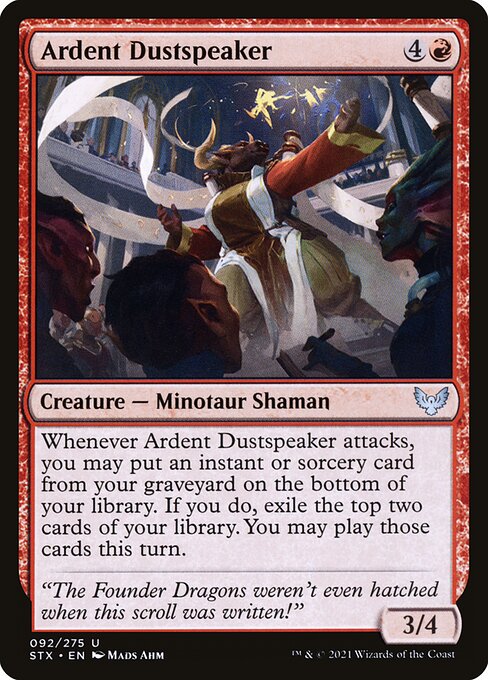
Image courtesy of Scryfall.com
Un-sets, Design Theory, and Ardent Dustspeaker: Why the Whimsical Shapes Modern Strategy 🧙♂️🔥
Design theory in Magic: The Gathering has always danced between strict rules and playful exceptions. The un-set philosophy—projects built to push boundaries with humor, nonstandard rules, and tongue-in-cheek interactions—has quietly shaped how mainstream sets think about player expectations, clarity, and the thrill of new interactions. In Strixhaven: School of Mages, we meet Ardent Dustspeaker, a red-headed spark plug of a creature whose ability embodies that tension: a bold attack trigger that rewards clever sequencing and graveyard storytelling. When you pair a card like this with the un-set mindset, you see design lessons bleed from joke cards into serious, high-skill gameplay. It’s a reminder that design thrives not just on power, but on playable promises and memorable outcomes 🧙♂️🎲.
Card snapshot: Ardent Dustspeaker as a case study
Ardent Dustspeaker steps onto the battlefield as a creature — Minotaur Shaman — with a formidable mana cost of {4}{R} and a sturdy 3/4 body. Its flavor-forward frame from Strixhaven: School of Mages (STX) carries the stamp of a set that loves magical mentorship and arcane experimentation. The card’s ability reads:
- “Whenever this creature attacks, you may put an instant or sorcery card from your graveyard on the bottom of your library. If you do, exile the top two cards of your library. You may play those cards this turn.”
That single line marries tempo with risk and reward in a way that feels almost un-set in spirit: attack triggers become a liminal space where what you choose to recycle from the graveyard, and what you exile off the top, can shape the entire turn. The interaction leans into a design lesson about clarity and agency—the player chooses, the rule compels, and the turn rewards bold sequencing. The flavor text—“The Founder Dragons weren’t even hatched when this scroll was written!”—narratively anchors Dustspeaker in a world where history, mischief, and studied risk all collide. It’s a wink that resonates with Un-set fans and traditional players alike ⚔️💎.
What un-sets taught designers that Dustspeaker embodies
Un-sets challenged us to rethink “how a card teaches you to play.” They experimented with non-traditional effects, jokes that revealed plausible rules interactions, and paradoxical mechanical space where the fun lies in understanding the design rather than merely exploiting it. That mindset invites designers to seek clarity even when the concept is flamboyant. Dustspeaker, with its graveyard recursions and turn-by-turn decision points, shows how a bold mechanic can harmonize with a strong mana curve and a clear risk/reward calculus. The result is a card that feels exciting to pilots who enjoy building around graveyard ecosystems, while still being approachable enough for players who simply want to attack and see what happens next 🧙♂️🎨.
Gameplay implications: tempo, choice, and legibility
There’s a deliberate cadence to Ardent Dustspeaker’s effect. On attack, you face a fork: do you pull an instant or sorcery from the graveyard, potentially replaying a key spell or flashback effect? If you do, you must exile the top two cards of your library, but you may play those cards this turn. That means your turn can swing from “clean combat damage” to “a cascade of plays,” provided you have the right subset of spells queued up in the graveyard and a plan for the top-of-library draw odds. This encourages deck builders to consider graveyard resilience, card selection, and linearity versus chaos—core themes that Un-set-inspired design nudges into mainstream design conversations. It’s not about raw value alone; it’s about weaving a narrative of risk, tempo, and a small but persistent spark of magic on the battlefield 🧙♂️🔥.
Design theory takeaways for collectors and players alike
- Spacing between power and playability: Dustspeaker’s 5-mana floor is balanced by an attack trigger that promises explosive turns if you sequence correctly. It’s a reminder that supporting cards in a deck should help create reliable lines of play, not just flashy moments.
- Graveyard as a resource: The option to replay a graveyard card mirrors how un-sets historically pushed players to rethink what counts as “playable.” If you design with graveyard recursion in mind, you can craft decks that reward planning and card advantage, not just tempo for tempo’s sake.
- Play-space clarity: Despite the potentially wild payoff, the rules are straightforward enough that players can reason about outcomes without flipping the rulebook. That balance—fun, yet not inscrutable—is a core payoff of un-set-inspired design thinking.
As a cultural artifact, Ardent Dustspeaker sits at an interesting crossroads: it’s a Strixhaven card with a design sensibility that nods to the un-set tradition. The flavor and mechanical clarity combine to deliver a moment in which casual players smile at the idea, while enthusiasts plot multi-turn sequences that feel almost ritualistic in their precision. And yes, the red mana crackle of its ability can spark a competitive spark in the right meta, especially when paired with graveyard-happy archetypes that thrive on castable value and dynamic turn structure 🧙♂️⚡.
Cross-promotional note: a handy desk side companion 🧳
While you’re contemplating Dustspeaker’s next big turn, why not upgrade your desk with a reliable MagSafe card holder, a small but mighty accessory that keeps cards, wallets, and tech in one streamlined setup? The product is a thoughtful nod to modern multitasking—a neat parallel to how Ardent Dustspeaker fuses multiple strategic ideas into a single, decisive moment. If you’re curious, you can explore the cross-promotional option here:
Magsafe Card Holder Phone Case (Polycarbonate – Glossy or Matte)
More from our network
Discover other perspectives from our growing MTG-focused network. Here are five reads you can dive into right after you finish decoding Ardent Dustspeaker’s design whisper.